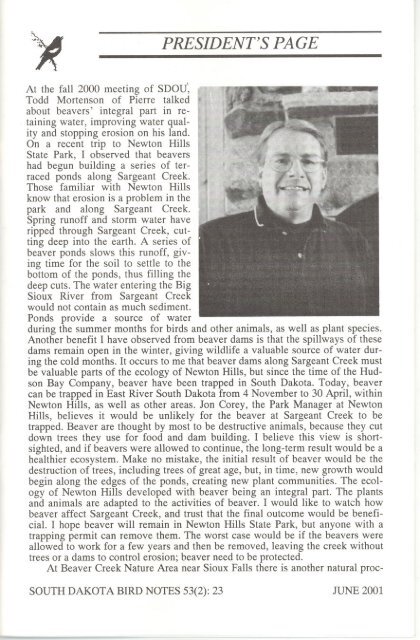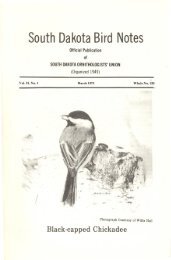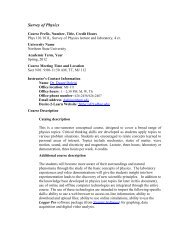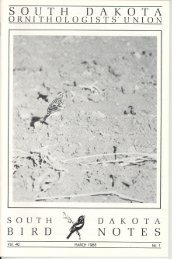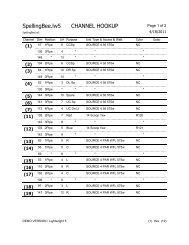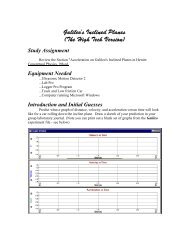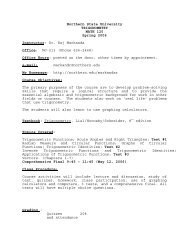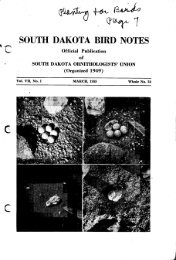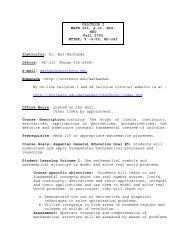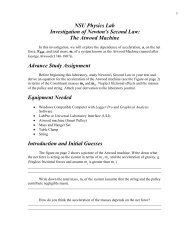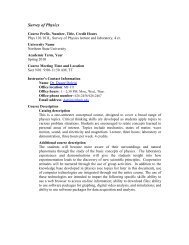SOUTH DAKOTA BIRD NOTES, the official publication of the South Dakota Ornithologists'Union (organized 1949), is sent to all members whose dues are paid for thecurrent year. Life members $200.00; Family life members (husband and wife) with 1subscription to Bird Notes $270; sustaining members $20.00, regular members $12.00;family members (husband and wife) with 1 subscription $16.00; juniors (10-16) $6.00;libraries (subscription) $12.00. Single and back copies: Members $3.50, Nonmembers$4.00. All dues payments, change-of-address notices, and orders for back copies shouldbe sent to the Treasurer, Nelda Holden, 1620 Elmwood Drive, Brookings, SD 57006.Manuscripts for publication should be sent to Editor Dan Tallman, NSU Box 740, AberdeenSD, 57401, or to Tallmand@northern.edu via E-mail.VOL. <strong>53</strong> JUNE ZO01 N{J.""ZIN THIS ISSUEGLOSSY IBIS, Karl BardonPRESIDENT'S PAGECover...23FIFfY YEARS OF SOUTH DAKOTA CHRISTMAS COUNTS, DanTallman 24GENERAL NOTES - A First Record for Glossy Ibis in South DakotaCHRISTMAS COUNTS ...,30.31BOOK REVIEWS .35SEASONAL REPORTS .35PresidentVice PresidentSecretaryTreasurerEditorLibrarianSOUTH DAKOTA ORNITHOLOGISTS'Officers1999- 2000UNIONRobb Schenck 422 N Linwood Ct., Sioux Falls 57103Todd Jensen 4001 Yucca Dr. #D, Rapid City SD 57702David Swanson USD, Vermillion 57069Nelda Holden 1620 Elmwood Drive, Brookings 57006Dan Tallman NSU Box 740, Aberdeen 57401Eric Likness USD, Vermillion 57069Elected DirectorsFor Term expiring <strong>2001</strong>: Gertrice Hinds, Prairie City; Jeffrey Palmer, Madison; RosemaryDraeger, Sioux Falls; Dan Tallman, Aberdeen; Duane Weber, Custer.For Term expiring 2002: Addison Ball, Piedmont; Todd Jensen, Rapid City; Travis Hills,Crooks; Karrie Schmidt, Huron; Robb Schenck, Sioux Falls.For Term expiring 2003: Vic Fondy, Whitewood; Linda Johnson, Sioux Falls; EricLikness, Vermillion; Ricky Olson, Pierre; Richard Peterson, Wewela.Past President DirectorsJocelyn L. Baker, L. M. Baylor, Gilbert Blankespoor, Robert Buckman, Ken Graupmann,Cecil Haight, Byron Harrell, Bruce Harris, Nelda Holden, Rex Riis, Dennis Skadsen,David Swanson, J. David Williams.Associate Editor: Erika TallmanSOUTH DAKOTA BIRD NOTES <strong>53</strong>(2): 22 JUNE <strong>2001</strong>
~PRESIDENT'S PAGEAt the fall 2000 meeting of SDOU~Todd Mortenson of Pierre talkedabout beavers' integral part in retainingwater, improving water qualityand stopping erosion on his land.On a recent trip to Newton Hills<strong>State</strong> Park, I observed that beavershad begun building a series of terracedponds along Sargeant Creek.Those familiar with Newton Hillsknow that erosion is a problem in thepark and along Sargeant Creek.Spring runoff and storm water haveripped through Sargeant Creek, cuttingdeep into the earth. A series ofbeaver ponds slows this runoff, givingtime for the soil to settle to thebottom of the ponds, thus filling thedeep cuts. The water entering the BigSioux River from Sargeant Creekwould not contain as much sediment.Ponds provide a source of waterduring the summer months for birds and other animals, as well as plant species.Another benefit I have observed from beaver dams is that the spillways of thesedams remain open in the winter, giving wildlife a valuable source of water duringthe cold months. It occurs to me that beaver dams along Sargeant Creek mustbe valuable parts of the ecology of Newton Hills, but since the time of the HudsonBay Company, beaver have been trapped in South Dakota. Today, beavercan be trapped in East River South Dakota from 4 November to 30 April, withinNewton Hills, as well as other areas. Jon Corey, the Park Manager at NewtonHills, believes it would be unlikely for the beaver at Sargeant Creek to betrapped. Beaver are thought by most to be destructive animals, because they cutdown trees they use for food and dam building. I believe this view is shortsighted,and if beavers were allowed to continue, the long-term result would be ahealthier ecosystem. Make no mistake, the initial result of beaver would be thedestruction of trees, including trees of great age, but, in time, new growth wouldbegin along the edges of the ponds, creating new plant communities. The ecologyof Newton Hills developed with beaver being an integral part. The plantsand animals are adapted to the activities of beaver. I would like to watch howbeaver affect Sargeant Creek, and trust that the final outcome would be beneficial.I hope beaver will remain in Newton Hills <strong>State</strong> Park, but anyone with atrapping permit can remove them. The worst case would be if the beavers wereallowed to work for a few years and then be removed, leaving the creek withouttrees or a dams to control erosion; beaver need to be protected.At Beaver Creek Nature Area near Sioux Falls there is another natural proc-SOUTH DAKOTA BIRD NOTES <strong>53</strong>(2): 23 JUNE <strong>2001</strong>
- Page 1: I .SOUTH DAKOTA IORNITHOLOGISTS'UNI
- Page 4 and 5: fication of Birds of North America
- Page 6 and 7: - - ~1180 individuals banded and 20
- Page 8 and 9: L--: --..Dean, K. L. 1999. Stopover
- Page 10 and 11: I was listening to an unusual sparr
- Page 12 and 13: ..of Black-backed Woodpeckers incre
- Page 14 and 15: .~24 Sep Meade JLB ... Late [l5-Nov
- Page 16 and 17: ..-- --- --Yankton SVS; 02 Aug Robe
- Page 18 and 19: ..American Tree Sparrow Early: 03 O
- Page 20 and 21: PubUshed bySOUl1l DAKOTAORNI1HOLOGI
- Page 24 and 25: ..ess that is being fought against.
- Page 26 and 27: White-fronted Goose 13% 6Snow Goose
- Page 28 and 29: Hairy Woodpecker 91% 41Black-backed
- Page 31 and 32: - - -Grzybowski, 1. A. 1999. Southe
- Page 33 and 34: en0ẹ..,::r:t:J~0~OJ....:;.:;t:JZ0
- Page 35 and 36: ~A GUIDE TO THE BIRDS OF THE PHILIP
- Page 37 and 38: Brookings KIE; 11 Feb Hughes RDORed
- Page 39 and 40: TJ; 20 Jan Hughes JSP, RFSPurple Fi
- Page 41 and 42: ~!I: ORNITHOLOGISTS'I SOUTH DAKOTAU
- Page 43 and 44: ..~PRESIDENT'S PAGEI had such a bla
- Page 45 and 46: -erably prior to consulting a field
- Page 47 and 48: SUBMITTEDFOR CONSIDERATIONEurasian
- Page 49 and 50: '"young cormorants, near flight sta
- Page 51 and 52: - --"only one genus of the family S
- Page 53 and 54: ~SEASONAL REPORTSThe 2001 Spring Se
- Page 55 and 56: ----KM; 08 Apr Butte JLBCinnamon Te
- Page 57 and 58: ,-----0Apr Minnehaha RBA; 17 May Be
- Page 59 and 60: Pileated Woodpecker Only Report: 15
- Page 61 and 62: 07 MayUnion RBA ...Late: 12 May McC
- Page 63 and 64: ,I~haha RFS, JSP; 11 May Meade EEMB
- Page 65 and 66: Contributing ObserversRBADBJLBKBAPB
- Page 67 and 68: .~lSD State Lists (31 December 2000
- Page 69 and 70: - ---- JSOU T H D A K 0 r~ORNITHOLO
- Page 71 and 72: ...~PRESIDENT'S PAGEThe September m
- Page 73 and 74:
emained at the refuge for 11 days b
- Page 75 and 76:
_INelson has cut back sunflower pla
- Page 77 and 78:
problems." He explained that Wildli
- Page 79 and 80:
within two hours.) Some non-target
- Page 81 and 82:
'\of USFWS, Mountain-Prairie Region
- Page 83 and 84:
takes three days for the bird to di
- Page 85 and 86:
- ,..,rcording to Gamble.NORTH DAKO
- Page 87 and 88:
~IrSMALL RESEARCH GRANTS AVAILABLE
- Page 89 and 90:
';IWhite-faced Ibis reported from H
- Page 91 and 92:
Whip-poor-will Reported from Lincol
- Page 93 and 94:
Meade, Pennington and Stanley co.Ea
- Page 95 and 96:
REPRFSSSNSSVSDRSDSRandy E. PodollRo


